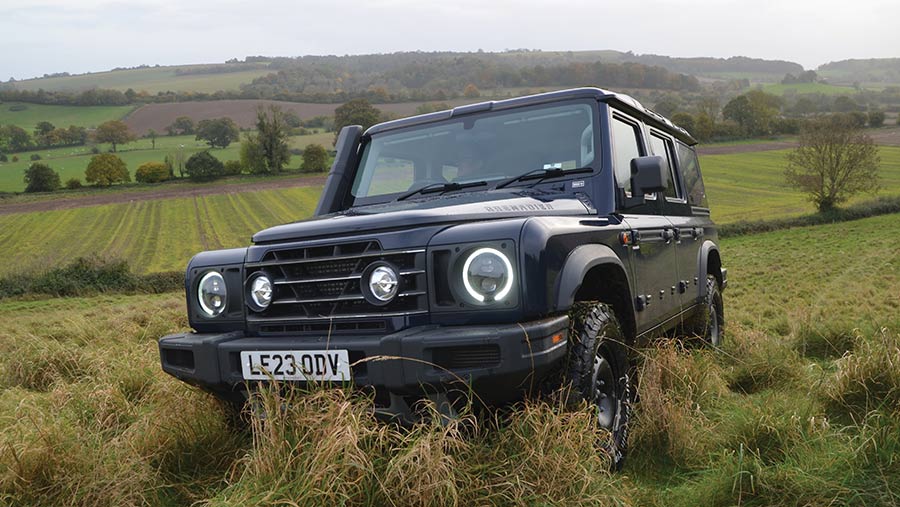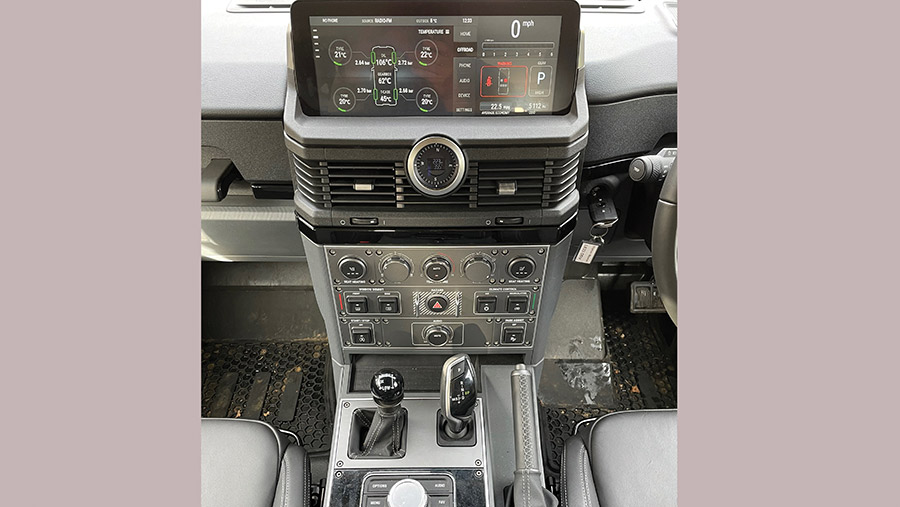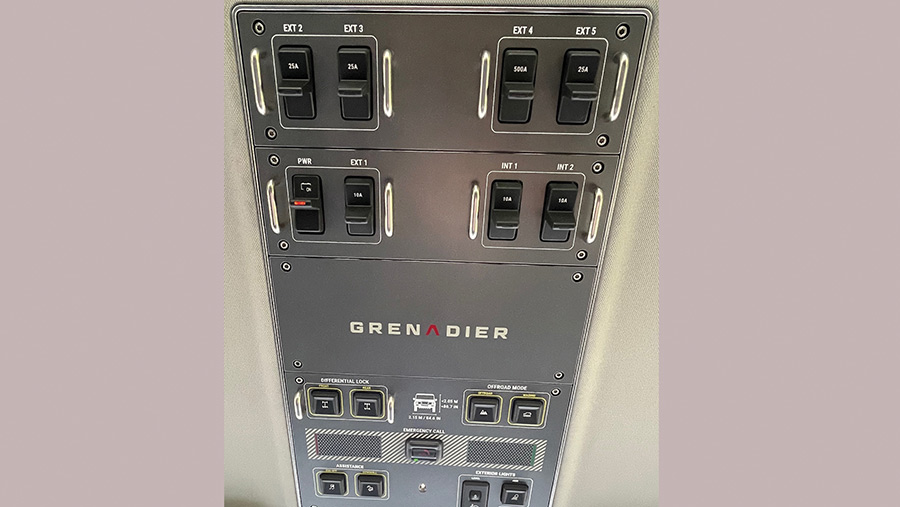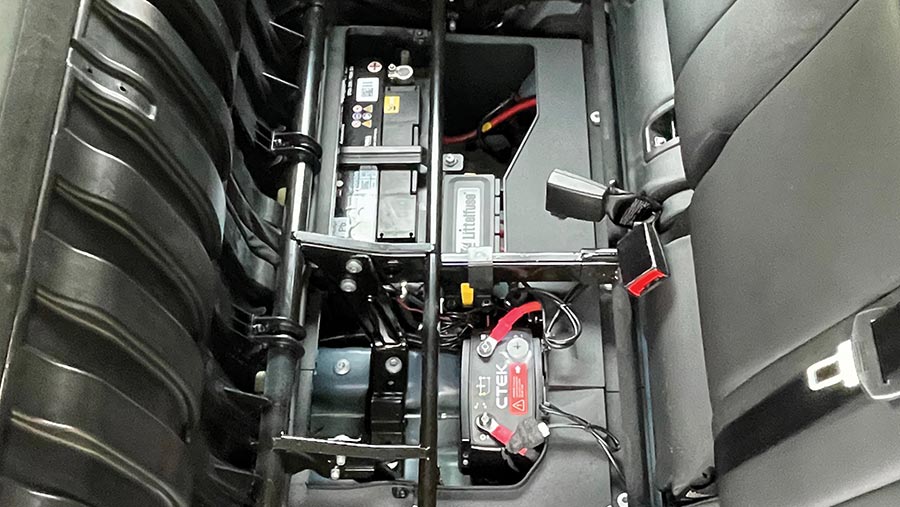On test: Ineos’s £79,000 Grenadier 4×4
 © Nick Fone
© Nick Fone While small numbers of Ineos’ long-awaited Grenadier have been trickling out across the country, they’re still something of a rarity.
Having tackled the inevitable rash of teething troubles that you’d expect with any completely new machine, the company says it’s now keen to get its ruggedised 4×4 out to the mainstream market.
Farmers looking for genuine replacements for old-school Land Rovers have a fairly limited choice and on paper it looks as if the Grenadier could be a true replacement for the defunct Defender.
See also: Pickup and commercial 4×4 buyer’s guide 2023-24
Ineos Grenadier Trialmaster
- Engine 3-litre, six-cylinder BMW twin-turbo
- Max power 245bhp@3,250-4,200rpm
- Max torque 550Nm@1,250-3,000rpm
- Gearbox Eight-speed ZF auto
- Driveline Tremec transfer case with central diff lock and optional electronic locking diffs in Carraro front and rear axles
- Weight 2,744kg
- Load capacity 760kg
- Towing capacity 3.5t
- Base price £64,500 (£78,730 as tested)
Like the Solihull stalwart, this rookie off-roader has a ladder-chassis, live beam axles and, critically, it will tow 3.5t. But despite its throwback appearance, that’s where the similarities end.
Power is provided by a 3-litre BMW straight-six driving through the same eight-speed ZF auto box used in Discovery 4s.
Coil-sprung Carraro axles carry the load and a transfer box from US transmission specialist Tremec slots in between.
In short, the Austrian engineering team tasked with designing the Grenadier played car component Top Trumps and ended up with some decent clobber from the parts bin.
(Those same guys also get credit for Mercedes G-Wagens and the Pinzgauer six-wheelers favoured by the Royal Marines.)
Mechanically, it all sounds like a match made in heaven, but does the Grenadier really make for a dream 4×4?
To find out, we put the station wagon Trialmaster version through a fairly rigorous 10-day test combining digger haulage, shepherding duties and some pretty unsympathetic off-roading.

© Nick Fone
Uneasy on the eye?
While beauty may well be in the eye of the beholder, it’s hard to see the Grenadier winning too many pageants.
It has the posterior of the G-Wagen, the hips of the original Defender and the pouty bottom lip of a Santana – Spain’s less-than-legendary Land Rover lookalike.
Despite that somewhat ugly external appearance, once you’ve scrambled into the cabin (it’s a long way up) everything feels a bit more serene.
Utilitarian without doubt, but the cabin is laid out logically and, despite having the inevitable touchscreen telly, most things are handled by proper old-school switchgear.
And that theme continues over the driver’s head. There is a whole bank of switches for winches, external power ports and hill descent control (mostly pointless to all but the most enthusiastic enthusiasts).
However, there are a few crucial bits that don’t want to be overlooked – the push-buttons that operate the optional front and rear diff-locks, in particular.

© Nick Fone
With aluminium rails around the switches in this overhead control panel there’s a definite attempt to give drivers that Maverick-and-Goose feeling. But you’re brought back down to earth when you lower your eyes.
Sprouting from the centre console there’s a gear selector stalk borrowed from a Beemer 5-series and a stubby stick for high and low ranges and the centre diff-lock (it’s only marginally less stubborn than the Land Rover equivalent).
To regular Land Rover drivers the Recaro seats will be a total revelation.
They are super comfortable and there’s no need to have the window permanently wound down for essential elbow room.
While it’s all good news on this front, there’s one major obstacle lurking in the driver’s footwell.
To accommodate the Bavarian-built six-pot’s exhaust there’s a hump where the driver’s left foot naturally falls. Initially, it felt very awkward, but after a few hundred miles it became less of an issue.

© Nick Fone
Heavy but quick
On the road, the Grenadier has a few surprises up its sleeve. Despite tipping the scales at just north of 2.7t, a good dose of right boot pushes it to 60mph pretty rapidly – all with a very satisfying growl.
And after nearly 2,000 miles behind the wheel we got a pretty good idea of another of its strengths: it’s really quite good at burning diesel.
It’s probably similar to a 10-year-old Transit-engined Defender in this respect, though it can at least produce significantly more oomph.
Off the blacktop, Ineos’s first-born really comes into its own. It’s fair to say we gave our loan car a pretty hard time – we took heavily rutted farm tracks head-on at 40mph when you’d normally crawl along it at a quarter of the pace in your own truck.
Incredibly, we were able to stay in our seats without clattering heads on roof, and the wheel wasn’t wrenched out of the driver’s hands with each pothole.
In fact, the vehicle feels particularly planted in this environment, with coil springs and an old-school steering box taking the sting out of unseen obstacles.
But, unfortunately, this is also the route of one the Grenadier’s biggest gremlins. Pull out from a junction and you’ve got to swing the tiller right over before it heads where you’ve got it pointed.
It’s a bit wayward in this respect – something Ineos says it’s working to improve.
In a similar vein, while generous suspension travel is a godsend in the sticky stuff, with a fully laden trailer hitched up, cornering at speed can feel wallowy.
That said, with nothing on the drawbar the bulky car handles pretty well through the bends.

© Nick Fone
FW verdict
We fell into liking the Grenadier much quicker than we’d anticipated. The combination of the torquey, throaty BMW six-cylinder and lazy eight-speed auto box was always going to score highly, and we weren’t disappointed.
However, the laws of physics cannot be ignored – hauling nearly 3t about inevitably generates a thirst.
There’s no getting away from comparisons with old-school Defenders, and Ineos’ first foray into this game brings a whole lot more refinement than Land Rover’s sixty-odd-year-old design.
We like the balance between modern tech and fix-it-yourself engineering. And the fact that the doors shut properly.
However, there’s a discrepancy between the Grenadier’s price tag and its spec.
If you’re going to splash out in excess of £70,000 on a car, you might expect it to have adaptive cruise control, wireless phone charging and an auto-darkening rear-view mirror – all gizmos you’d get on a £20,000 hatchback from South Korea.
And then there’s the small issue of VAT. Despite Ineos marketing its two-seat Utility Wagon variant as a commercial vehicle and it being able to accommodate a full-size Euro pallet in the boot, it actually doesn’t qualify in the eyes of HMRC, so you can’t reclaim any of the tax from the purchase price.
Likewise, the long-wheelbase Quartermaster double-cab pickup – because its load capacity is sub-1t (max 830kg), it too fails to qualify for VAT redemption.
Would we have one? If there was a spare £70,000 rolling around in the current account and you needed a proper off-road/towing car then you’d have to seriously consider the Grenadier alongside a new Defender or Land Cruiser Commercial.
We appreciate its unapologetic utilitarianism translates into unrivalled off-roading ability and Discovery-matching towing capabilities.
Ineos just needs to get that UK-specific VAT issue sorted.
Likes and gripes
Likes
- Resilient load lugger thanks to torquey Beemer motor
- Beam axles, coil springs and ladder chassis good off-road
- Comfortable ride
- Relatively simple fix-it-yourself design
Gripes
- Spec doesn’t match hefty top-end price
- Lack of VAT-efficient commercial models
- Makes thirsty work of motorway miles
- Wallowy suspension and vague steering result in slightly wayward handling

